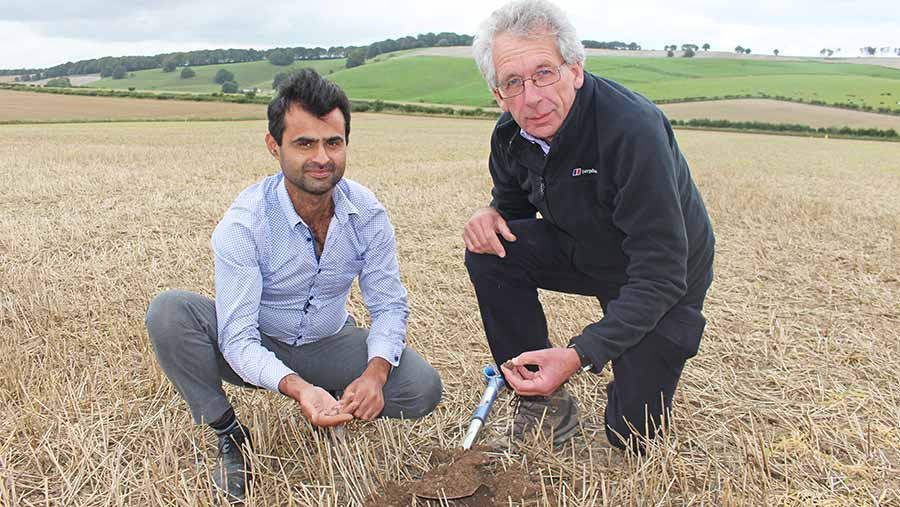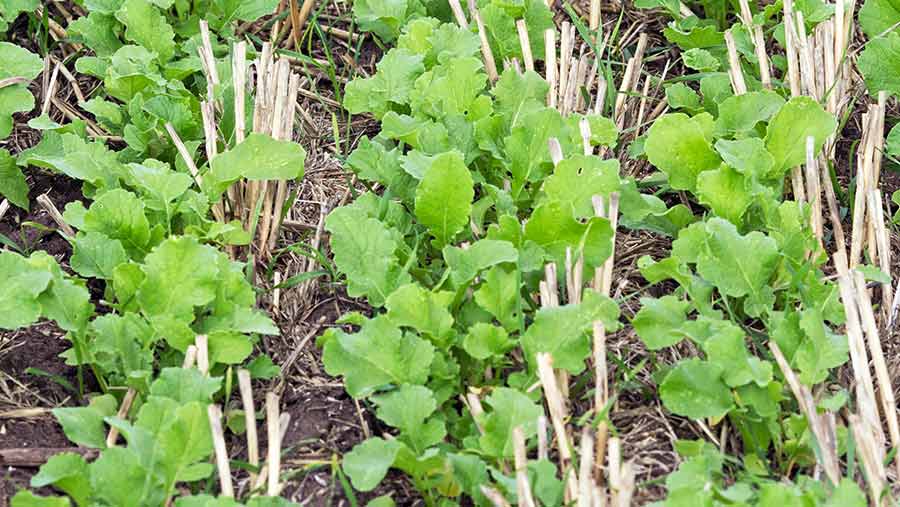Tips on how to get your soils back in to better shape
Up to 30% of the yield from the UK’s record-breaking wheat crop in Northumberland came from water stored in the soil, highlighting the importance of healthy soils.
And given that 40% of wheat in the UK is grown on drought-prone land, having soils that can hold more water will produce crops that can cope better with periods of low rainfall.
Andrew Richards, senior agronomist and business development manager at Agrii, points to this season as a good example of why farmers need to get their soils into better shape.
He says: “We have seen six to eight-week cycles of extreme dry or wet, with the dry spring followed by a wet summer. So how do we get some resilience back into our soils?”
See also: Top tips from two US no-till and cover crop veterans

Dr Syed Shah and Andrew Richards
One challenge is the lack of a definition for soil health, which would allow farmers to measure any improvements resulting from changes in management.
The problem is that soil biology is hugely complex. One spade full of soil contains more species than that seen above ground in the entire Amazon Rainforest, says Mr Richards.
Despite this, some soil analysis labs are promoting measures of soil health costing up to £130-£140, which he believes are pretty meaningless. One example is the use of carbon dioxide emissions as an indicator of biological activity.
Mr Richards says: “The respiration measured could be down to take-all fungus,” he says. Also it can vary hugely across a field, so farmers can end up drawing the wrong conclusions.”
Defining soil health
Agrii R&D manager and agronomist Syed Shah believes that there is no substitute for going into the field and assessing soil health.
He has four measures that, when taken together, offer a baseline to help farmers measure if any improvements are being seen in soil health when making changes.
First is soil compaction/drainage. For soils to function, water needs to infiltrate and be stored.
The second measure is organic matter content, which acts like a sponge for holding water, followed by pH.
The fourth is soil biology. Dr Shah says earthworm numbers are the most reliable indicator, as you see lower numbers in soils that are waterlogged, compacted, have a low organic matter content or are acidic.
For worms, he advises farmers count them in November or spring when soils are slightly wet and they are near the surface. Count the middens, which are piles of organic debris (twigs, leaves, straw and stones) gathered by anecic earthworms.
Typical values seen are 0-3g/sq m for plough-based systems, 3-15g/sq m for min till and 15-60g/sq m for zero-till.
Sources of organic matter
So how can you increase earthworm numbers? Adding organic matter to soils helps and Mr Richards points to an Agrii trial where soils that did not receive compost had only one-third of the number of those that did.
However, not all organic sources are the same. For example, a subsequent Agrii trial found that chicken manure reduces worm numbers because of its acidity.
The trial compared different sources (chicken manure, compost, farmyard manure and biosolids) applied over four years with cropping consisting of spring barley followed by oilseed rape and winter wheat.
All treatments improved soil organic matter levels, but to differing levels. Green compost came top, but that was when applying a large amount.
Dr Shah concludes that farmyard manure is the preferred source in most situations, culminating in 1.75t/ha extra Gallant wheat yield over the untreated.
However, the other organic sources do have roles in some situations (see table).
Cultivation systems
Another factor to bear in mind when looking to improve soil health is the effect of the cultivation system.
“You can see organic matter burn off with more intensive cultivations. Also worm numbers are higher with less intensive cultivations,” says Dr Shah.
Dr Shah highlights an Agrii trial that compared four systems, the Amazone EDX and the Vaderstad rapid drill in a two-pass system with a single pass of a Cross Slot or the Opico Sky Drill.
He recorded 56-60g/sq m of earthworms for the two passes compared with 100-120g/sq m with single pass.
So an additional pass had a significant effect on earthworm numbers. He concludes that less cultivation is better.
One exception is where poor compaction needs resolving. He says: “If compaction is a problem, earthworm numbers will already be low so will need tackling by subsoiling.”
Four measures of soil health
- Drainage/compaction (needs good infiltration)
- Organic matter content (affects drainage, compaction, soil and drought)
- Soil pH (affects soil biology and nutrient availability)
- Soil biology (earthworm numbers – 150g/sq m is a good number)
Sources of organic matter at a glance
| Organic matter source | Where best to use | Pitfalls |
| Chicken manure | Soils with high pH as will increase organic matter levels | Care, as chicken manure will reduce earthworm numbers |
| Compost | Can help improve the water holding capacity of soils and also delivers some trace elements | Can increase soil organic matter levels, but need to apply high amounts |
| Farm yard manure | Best of the organic sources for earthworm numbers and opening up structure on heavy soils | Avoid on very sandy soils as infiltration rates. Consider compost instead |
| Biosolids | Useful for phosphates as can improve soil P indices |
What about cover crops?

© Tim Scrivener
Cover crops have a very limited role in raising organic matter levels, although they are useful in reducing erosion, capturing nutrients as well as breaking compaction.
Growing a cover crop has been touted as a way of increasing soil organic matter levels, however, farmers would be better off applying compost or farm year manure instead.
Agrii R&D manager and agronomist Syed Shah has calculated that it would take 18t/ha of organic carbon from the crops being incorporated in the top 15cm of soil to raise soil organic matter content from 2% to 4%.
This would take 30 years, assuming a cover crop typically produces 600-800kg of carbon/ha. It could take even longer, as some of this will be lost (burn off) while being incorporated.
Despite this, he believes cover crops can still have a valuable role, as highlighted in Agrii trials carried out in 2012-13 investigating different mixes grown before a crop of Tipple spring barley.
Cover crops captured 60-90kg/ha of nitrogen, which may otherwise have been leached over the winter.
This translated into a barley yield increase of 0.8t/ha compared with overwintered stubble. There may be other factors like improved soil structure, however, he believes a good proportion is down to the extra nitrogen released the following spring.
Timing
However, timing of crop destruction is important as this affects when this nitrogen is released.
That’s because the carbon to nitrogen ratio changes as the crop matures with more lignin being produced. The higher the carbon, the slower the nitrogen is released, explains Dr Shah.
Andrew Richards, senior agronomist and business development manager at Agrii, adds that some US farmers monitor the crop’s C to N ratio and alter the timing of its destruction to get the release that spring.
The species grown also affects the rate nitrogen is released, with oil radish, oats, phacelia and buckwheat tending to be slower at releasing nitrogen, while vetch and Bersleem clover is more rapid, two months after.
Dr Shah also highlights that P and K release is much slower, taking six months to a year.
Therefore, farmers may need to consider adding some P and K in the seedbed for subsequent spring crops to compensate for this uptake.
Cover crops
- Slow way to increase soil organic matter
- Capture up to 90kg/ha of nitrogen
- Timing of glyphosate affect when nitrogen is released

Farmers Weekly is running the first Soils in Practice conference at Glebe Farm, Leadenham on November 8th 2017.
This one-day event will provide a unique opportunity to learn more about managing soil.
Through presentations and practical sessions with expert speakers, delegates will learn: how to measure and monitor soil health, build a machinery policy to protect soil, enrich organic matter levels, conservation strategies.
Find out more about the Soils in Practice conference and book your ticket.
